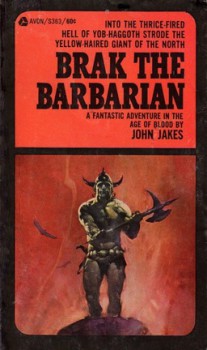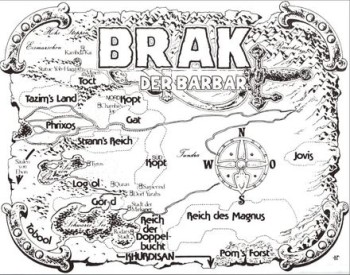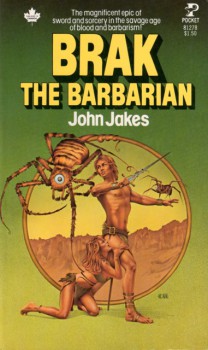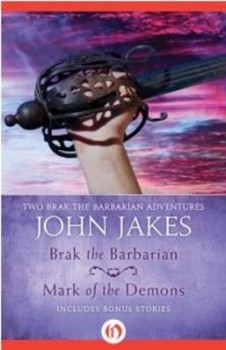On the Road to Khurdisan: Brak the Barbarian by John Jakes
 For people of a certain age (the pushing-fifty crowd) John Jakes is probably best known for The Kent Family Chronicles, his massive series of massive books about American history and the mini-series made from the first one, The Bastard. Hearing that title said out loud on TV was a pretty shocking thing for us kids back in 1978.
For people of a certain age (the pushing-fifty crowd) John Jakes is probably best known for The Kent Family Chronicles, his massive series of massive books about American history and the mini-series made from the first one, The Bastard. Hearing that title said out loud on TV was a pretty shocking thing for us kids back in 1978.
It wasn’t until I was a little older that I discovered John Jakes had started his career as a real journeyman pulp writer. While working in advertising, he wrote science fiction, westerns, mystery, and horror stories for all the major genre magazines. His name appears on the contents page of Fantastic Adventures and Amazing Stories, as well as Tales of the Frightened (easily one of my favorite titles for anything ever).
While Robert E. Howard had created the basic template for swords & sorcery back in the 1930s, it wasn’t until several decades later that the genre really exploded. Fritz Leiber and Sprague de Camp labored throughout the 50s, but it’s in the early 60s that S&S really takes off. Suddenly, Lin Carter’s writing his Howard/Edgar Rice Burroughs mashups, Michael Moorcock’s inverting and mocking many of the field’s cliches while still writing exciting tales, and Andre Norton is expanding S&S’s vison beyond the too-common male thud and blunder.
In 1963, with “Devils in the Walls” published in Fantastic, Jakes introduced his own barbarian hero, Brak. In a 1980 preface to a new editon of the first collection of stories, Brak the Barbarian (1968), he wrote:
It was in the role of dedicated Conan fan that I wrote the first Brak tale, Devils in the Walls. In spirit, anyway, the story was a Howard pastiche, and I have acknowledged the fact more than once.
In an earlier preface he was explicit about why he created Brak:
My motive for giving birth to Brak and his parallel universe on an old black iron Underwood was much simpler. There just are not enough stories of this kind to go around any more; not enough, anyway, to please me.
To help fill this dismal gap well or badly — I hope never indifferently — my barbarian, with the long yellow braid and the light of the south horizons glittering in his eyes, was born.
Over the years, I’ve seen Brak dismissed as simply one of the many Conan-clones that appeared during S&S’s heady golden age from the 60s to early 80s. I’m here to tell you that, while Brak the Barbarian isn’t going to change your world, nor that it’s some sadly underrated classic, it is a fun way to kill a couple of hours. While Jakes’s prose is fairly humdrum, he does excel at creating terrific opponents and monsters. The plots of the last two stories are almost very good, something the shopworn ones of the first three aren’t. Brak’s stories are a lesser S&S vintage, but they sure aren’t vinegar; instead a solid pretty alright house wine.
If one of the reasons you read heroic fantasy is to escape to exotic lands crawling with savage beasts, wicked sorcerors, and evil femme fatales where the hero’s fate relies on a strong arm and quick thinking, then  this is a book for you. At the very least, for a sense of where S&S was in between REH’s day and our own, this is worth a look.
this is a book for you. At the very least, for a sense of where S&S was in between REH’s day and our own, this is worth a look.
At the start, Brak is your standard-issue northern barbarian. Clad in a lion skin loincloth and a heavy fur robe, he is making his way south to the sunnier climes of golden Khurdisan. Enticed by stories of a warm land filled with gold, women, and adventure, and banished by his own people for not treating their customs or gods reverently, in “The Unspeakable Shrine” he has lit out from his homelands in the frozen north. Over the course of that story and the four that follow, Brak covers the first leg of his southward trek finding, of course, all manner of obstacles along the way.
On his first night in the very first city he’s ever seen, Brak runs afoul of two evil immortals: the sorceror Septegundus and his daughter Ariane. He is captured by their servants in the squalid streets of Kambda Kai. Brak’s captors are the first indication of Jakes’s talent for creating grotesque enemies for his hero:
The boys formed a half-circle just up the street. They were ragtag, underfed, dirty-skinned waifs with straggly hair and pointed wolf’s teeth. The big barbarian noticed with a start that something was amiss in their faces.
Where eyepits should have been, each boy carried two silver-crystal disks somehow embedded between eyebrow and cheekbone. Their fingertips, too, were made of this silver-crystal stuff, pointed, like needles.
After his unsuccesful encounter with Septugundus’s minions, he ends up imprisoned, inside a gigantic idol of the demon-god Yob Haggoth, and ready to be served up for dinner. Fortunately, Brak’s well-formed physique and indomitable spirit catch Ariane’s eye. Inadvertenly, she provides him with the means of his eventual escape. Pretty standard old school S&S fare, in other words.
 The next two stories, “Flame-Face” and “The Courts of the Conjurer”, are equally run-of-the-mill. Brak is enslaved in fiery mines haunted by the terrible Doomdog (one of Jakes’s terrible monster names) in the first, and hired to kill a wizard protected by the Fangfish (boom! another terrible monster name) in the second. Neither story is particularly noteworthy, but Brak starts to take shape during them: though unimpressed by his deity, Brak insists on proper burial for a kindly priest he encounters in his travels; even as she’s stabbing him with a dagger, Brak is almost constitutionally unable to kill a young woman; he feels serious fear during some of his encounters and loses many of his fights. Maybe I’m being generous, and sure, Brak always wins in the end, but I like that there’s a touch of fallibility to a pretty stock character.
The next two stories, “Flame-Face” and “The Courts of the Conjurer”, are equally run-of-the-mill. Brak is enslaved in fiery mines haunted by the terrible Doomdog (one of Jakes’s terrible monster names) in the first, and hired to kill a wizard protected by the Fangfish (boom! another terrible monster name) in the second. Neither story is particularly noteworthy, but Brak starts to take shape during them: though unimpressed by his deity, Brak insists on proper burial for a kindly priest he encounters in his travels; even as she’s stabbing him with a dagger, Brak is almost constitutionally unable to kill a young woman; he feels serious fear during some of his encounters and loses many of his fights. Maybe I’m being generous, and sure, Brak always wins in the end, but I like that there’s a touch of fallibility to a pretty stock character.
With the last two stories, “Ghosts of Stone” and “The Barge of Souls”, Brak’s tales become a little more memorable. In the first, Brak loses his pony and becomes helplessly stranded in a desert he was warned quite emphatically to avoid. The advent of a greedy old scholar in search of an ancient treasure, and accompanied by his daughter, lead the blond warrior into further danger as he’s forced to help open the vaults of a city cursed long ago by Septegundus.
In “The Barge of Souls,” easily the best story in the book, Brak wanders a haunted battlefield, is forced to impersonate a dead royal consort, and saves a young queen and her kingdom. While Jakes does find time for a fight with a giant scaled slug, there’s more going on in “The Barge of Souls” than in any of the other stories. Brak’s characterization grows considerably as we see him take on the burden of righting several wrongs and repaying a great debt not with bloodshed, but backbreaking menial labor. Jakes clearly has laid down a marker that his hero will be a good guy, lacking the more roguish and mercenary traits of his forebear Conan.
Jakes’s writing also gains a little more life in these two stories. The generic landscape and feel of the earlier stories is replaced by a better sense of place and atmosphere. There’s a great passage when Brak is crossing the corpse-littered battlefield:
Riding in the smoke all day long, Brak occasionally heard a moan of pain from some survivor. Twice he reined in. Twice he attempted to locate the source of the cry. Each time, tricks of illusive gray light, of shifting smoke, of silk banners tattered but flapping, bedeviled him. Each time he became hopelessly lost, and failed to locate the wounded man.
On three other occasions, Brak passed ghostly parties of men silently crossing the battleground. The men carried tapers that winked eerily in the blowing smoke. They halloed to one another. Burial parties from Phrixos? So Brak assumed.
 Maybe I’m a voice in the wilderness, but I like this book. Not a lot and I’ll probably never read it all the way through again. But I do like it. In the absence of more Conan stories, John Jakes set out to make his own contribution to S&S instead of waiting around for someone else to do it for him. He’s got a feel for the stuff in a way that Sprague de Camp never did or that Lin Carter was rarely able to convey. He also took it at face value, understanding that it’s okay to write no-frills heroic fantasy that isn’t seeeking to deconstruct the genre. Sometimes wizard- and monster-killing is just what readers need.
Maybe I’m a voice in the wilderness, but I like this book. Not a lot and I’ll probably never read it all the way through again. But I do like it. In the absence of more Conan stories, John Jakes set out to make his own contribution to S&S instead of waiting around for someone else to do it for him. He’s got a feel for the stuff in a way that Sprague de Camp never did or that Lin Carter was rarely able to convey. He also took it at face value, understanding that it’s okay to write no-frills heroic fantasy that isn’t seeeking to deconstruct the genre. Sometimes wizard- and monster-killing is just what readers need.
Jakes was also a a charter member of the Swordsmen and Sorcerers’ Guild of America (SAGA), the group founded by Lin Carter to promote S&S. The initial members also included Poul Anderson, Sprague de Camp, Fritz Leiber, Michael Moorcock, Andre Norton, and Jack Vance. That’s pretty prestigious company to be in.
The old paperbacks of the Brak series (Brak the Barbarian, Brak Versus the Sorceress, Mark of the Demons, When Idols Walked, and The Fortunes of Brak) are easily found and are also available as a two-volume ebook release from 2012.
BONUS: Here’s a short video of Jakes talking about his loincloth-wearing hero. A tip of the hat to Paul McNamee for hipping me to it.
http://video.openroadmedia.com/QAfAq/brak-the-barbarian-by-john-jakes/
Thanks for the post. Being of that certain age, I was shocked about 12 years ago to learn Jakes had written S&S. I was only familiar with the Kent Family Chronicles.
I’ve got a couple of these collections but have never read them. I’ll try to work them in over the holidays. I may also give The Best of John Jakes a try.
Here is one more tip; when Open Road Media released the two ebook omnibuses, for some reason one story was left out but was offered for free as a teaser. (why it also wasn’t included in one of the omnibuses, I cannot fathom.)
Anyway, you can read “The Girl in the Gem” for free at the following link.
https://www.scribd.com/doc/98228262/The-Girl-in-the-Gem-by-John-Jakes
@westkeith – just looked up Best of over at the ISFDB and it looks like it’s mostly science fiction from the sixties. It looks like his earlier stuff from the fifties has never been reprinted.
I haven’t read MENTION MY NAME IN ATLANTIS, Jakes’ parody/pastiche of S&S tales, since it was originally published, but I found it very funny at the time.
@Bill – I’ve already added it to my towering TBR list. I remember it being pretty funny as well. Unlike the Brak books, though, it hasn’t been given the e-book treatment.
Jakes actually wrote a lot of adventure-oriented SF and fantasy before his ship came in. I read a tasty bit of his sword and sorcery from 1969 not long ago, a novel called “The Last Magicians.” It won’t make anyone forget the greats in the field, but for anyone who loves the genre it was an intelligent use of the conventions and a lot of fun.
Last year, I tried to read ‘Devil in the Walls’ and gave up a couple chapters in. Just didn’t work for me at all.
But Fletcher’s post convinced me to give ol’ Brak another chance, so I’m starting on the short story, ‘Ghoul’s Garden.’
Hi Fletcher, luminous Mrs. V here.
I have a question about your standards for giving a positive review. I think that if you were reviewing Jakes as a contemporary writer you wouldn’t be so generous as you’ve been here. The very things you call him out for in this review would have ended him up with a more-negative-than-positive review elsewhere. The “bad” name thing alone seems to push you toward a negative review. I think your fondness for the golden age has led you to be more forgiving of Jakes than you are of the new guys.
I wish I could give you a concrete example, but I just looked through several short story roundups and couldn’t support my statement, but I’m still curious to hear what you have to say.
xo
@Hallie – If a story is well-plotted, exciting, has an interesting hero, and is not saddled with cliches, I’m generally happy enough to recommend it. Those are my base requirements for a S&S story.
When those things are done with originality or superior skill, that’s when I get really a thrill. When I review a book like God Stalk or The Great Captains I try to make clear how they rise above the minimal levels of competent S&S making them special books truly worth a reader’s time.
I don’t think I’m overly generous with older writers, I just get a little more nostalgic in the reviews. The Brak stories, especially the last two, are solid and I think the today’s typical S&S fan would enjoy them. When an older book, Lin Carter’s Kellory and Michael Moorcock’s The Eternal Champion, is weak I think I state that clearly.
What you don’t see are the older books I’ve simply avoided. I intended to read and review Sprague de Camp’s The Fallible Fiend but gave up after two chapters.
I’m wondering if the similarity between Khurdisan and Kurdistan is a coincidence?
An indisputable example of a SciFi story with a nation loosely based on the Kurds would be Gundam 00 who’s mean protagonist was a Krugis.